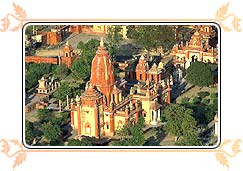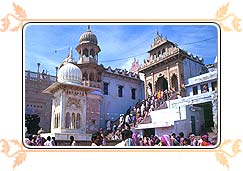Sripuram Golden Mahalaxmi Temple, Thirumalaikodi, Near Vellore, Tamilnadu.
Please wait for a while as the Image will automatically load in slide-show view.
Golden Temple - when uttered this word, immediately people thinks of Amritsar and the Highest Body of the Sikh's pride Golden Temple. But now it has got a good competition! Yes, an estimated over 600 Crores of Indian Rupees spent, to construct a true Golden Temple for Goddess Mahalakshmi, the presiding deity, (installed and maintained by Sri Narayani Peedam) in this Temple at Sripuram, which is situated 6 km away from the District Headquarters - Vellore, North Arcot District in Tamilnadu. Now, the temple is complete, open to the general public; this town Sripuram has all the facilities one can visit to enjoy his/her spiritual experience.
A Mahalakshmi temple called 'Sripuram' and made of more than a ton of pure gold will glitter and gleam under the sun on August 24 when it is unveiled for consecration by the Sri Narayani Peetam headed by a 31-year-old god man who calls himself Narayani Amma. Devotees hail the temple as 'one of the wonders of the world' and say that it is the only temple covered fully with gold.
More than 400 gold and coppersmiths from the Tirupathi Thirumala Devasthanam are said to have worked for six years to craft the Rs. 600-crore golden temple located on 55,000 sq ft of land on a 100-acre salubrious stretch in Malaikodi, about 6 km from Vellore in north Tamil Nadu. According to official sources, the gold bars were purchased through RBI in "a transparent manner "
First the coppersmiths set to work creating a copper base on the temple structure with engravings and etchings before the gold, beaten into nine layers of foils, was draped around it. The sanctum sanctorum will hold the deity of Mahalakshmi made of stone granite, but covered with gold protection layers. (Kavacham - adornments).
" The Sripuram or Spiritual Park is Amma's dedication to the world and mankind," said P Murali, a trustee of the Peetam, adding that the temple has more gold than the Golden Temple of Amritsar.
Messages by 'Amma' have been laid out along the path to the temple with messages from the Gita, Bible and Quran. "When one enters the Sripuram, their focus is just on the magnificent temple. But when they leave, they cannot do so without taking some messages and gaining some wisdom," according to a booklet detailing the 'services' rendered by the Peetam. "In this quagmire of materialism, Sripuram rises as an inspiration to man to find the divinity within him," adds a Narayani Peedam brochure.
The arrangements were being made to hire personnel to throw a security cover around the temple. "But the gold sheets have been laid out in such a manner that it would cost more to rip it off than purchase the gold," said a top Vellore district official.






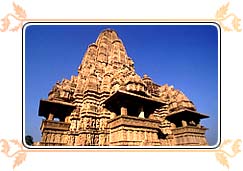 Khajuraho is now a quiet village. The town of exotic temples, Khajuraho is one of India's major honeymoon attractions. They are India's unique gift to the world, representing a melody to life,which encompasses all emotions ranging from love, to joy. Life, in every form and mood, has been captured in stone, testifying not only to the craftsman's artistry but also to the extraordinary breadth of vision of the Chandela kings.
Khajuraho is now a quiet village. The town of exotic temples, Khajuraho is one of India's major honeymoon attractions. They are India's unique gift to the world, representing a melody to life,which encompasses all emotions ranging from love, to joy. Life, in every form and mood, has been captured in stone, testifying not only to the craftsman's artistry but also to the extraordinary breadth of vision of the Chandela kings. 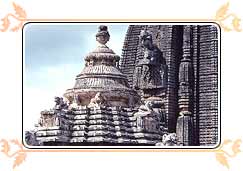 The People
The People 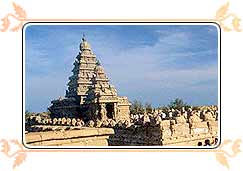
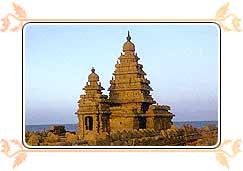 Perched on a rocky outcrop, it presides over the shoreline, serving, as Percy Brown puts its, 'a landmark by day and a beacon by night'. Designed to catch the first rays of the rising sun and to illuminate the waters after dark, the temple ended up with an unusual lay-out. As the main shrine faces the sea on the east, the gateway, the fore count and the assembly hall of the Shore Temple all lie behind the sanctum.
Perched on a rocky outcrop, it presides over the shoreline, serving, as Percy Brown puts its, 'a landmark by day and a beacon by night'. Designed to catch the first rays of the rising sun and to illuminate the waters after dark, the temple ended up with an unusual lay-out. As the main shrine faces the sea on the east, the gateway, the fore count and the assembly hall of the Shore Temple all lie behind the sanctum. 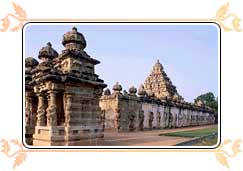
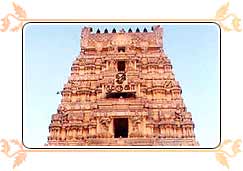 Ekambareshwar temple is of hoary antiquity, beginning as a small fane, it has grown over the centuries into a large one with innumerable shrines, Mandapams, Gopurams and Tanks. It is considered to be one of the most ancient temples in India and has been in existence even prior to 600 AD. It enshrines many traditions.
Ekambareshwar temple is of hoary antiquity, beginning as a small fane, it has grown over the centuries into a large one with innumerable shrines, Mandapams, Gopurams and Tanks. It is considered to be one of the most ancient temples in India and has been in existence even prior to 600 AD. It enshrines many traditions.